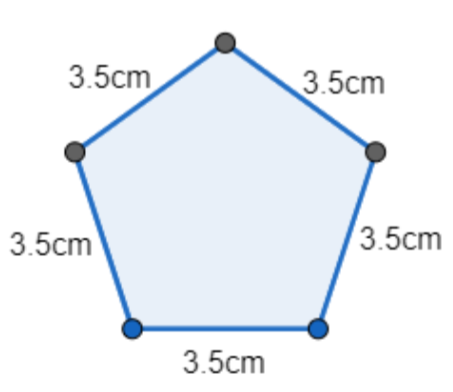
A side of a regular polygon is 3.5 cm in length. The perimeter of the polygon is 17.5 cm. How many sides does the polygon have?
Answer
501.3k+ views
3 likes
Hint: As we have the length of a regular polygon = 3.5 cm. The perimeter of the polygon = 17.5 cm. Since we know that the perimeter is the sum of all the sides of a polygon. So, we need to divide the perimeter by the given side to get the number of sides of the given polygon.
Complete step-by-step solution:
As it is given that, the polygon is regular. Therefore, the length of each side of the polygon is 3.5 cm.
Also, we know that the perimeter of the polygon is the sum of all the sides.
So, for a regular polygon of side a, we can have:
So, for the given polygon, we can have:
Therefore, we get n = 5
So, the regular polygon has 5 sides.

Hence, we can say that the polygon is a regular pentagon.
Note: The method to find the number of sides using the perimeter and given length of the side by the formula:
Complete step-by-step solution:
As it is given that, the polygon is regular. Therefore, the length of each side of the polygon is 3.5 cm.
Also, we know that the perimeter of the polygon is the sum of all the sides.
So, for a regular polygon of side a, we can have:
So, for the given polygon, we can have:
Therefore, we get n = 5
So, the regular polygon has 5 sides.

Hence, we can say that the polygon is a regular pentagon.
Note: The method to find the number of sides using the perimeter and given length of the side by the formula:
Latest Vedantu courses for you
Grade 8 | CBSE | SCHOOL | English
Vedantu 8 CBSE Pro Course - (2025-26)
School Full course for CBSE students
₹45,300 per year
Recently Updated Pages
Master Class 11 Economics: Engaging Questions & Answers for Success

Master Class 11 Business Studies: Engaging Questions & Answers for Success

Master Class 11 Accountancy: Engaging Questions & Answers for Success

Questions & Answers - Ask your doubts

Master Class 11 Accountancy: Engaging Questions & Answers for Success

Master Class 11 Science: Engaging Questions & Answers for Success

Trending doubts
Full Form of IASDMIPSIFSIRSPOLICE class 7 social science CBSE

Whom did king Ashoka send to Sri Lanka to spread Buddhism class 7 social science CBSE

The southernmost point of the Indian mainland is known class 7 social studies CBSE

How many crores make 10 million class 7 maths CBSE

AIM To prepare stained temporary mount of onion peel class 7 biology CBSE

Find HCF and LCM of 120 and 144 by using Fundamental class 7 maths CBSE





